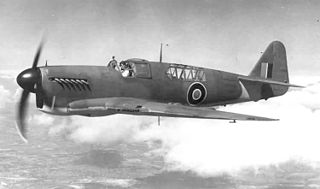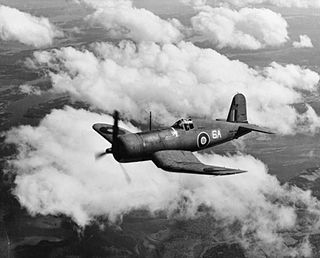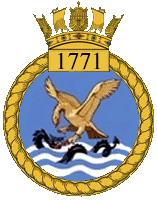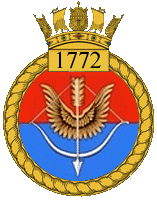
886 Naval Air Squadron was a Naval Air Squadron of the Royal Navy's Fleet Air Arm. It was formed at HMS Merlin, RNAS Donibristle, as a Fleet Fighter squadron during March 1942. The squadron was loaned to RAF Fighter Command during the summer of 1942, returning the Fleet Air Arm later on in the year. 1943 saw it participate in Operation Avalanche, part of the Allied invasion of Italy. The following year it was involved with operations over Normandy, spotting for the allied invasion of France from 6 to the end of June 1944, disbanding the following month.

1791 Naval Air Squadron was a Naval Air Squadron of the Royal Navy's Fleet Air Arm (FAA). It was formed on 15 March 1945 at HMS Daedalus, RNAS Lee-on-Solent as a Night Fighter squadron. It was equipped with Fairey Firefly NF.Mk I. The squadron joined HMS Puncher in June for deck landing practice but saw no action. Following V-J Day the squadron was disbanded on 23 September 1945 at HMS Ringtail, RNAS Burscough.

732 Naval Air Squadron was a Naval Air Squadron of the Royal Navy's Fleet Air Arm (FAA). It was initially formed in 1943 from a requirement for an Operational Training Unit for United States trained FAA pilots flying Vought Corsair fighter-bomber aircraft, at RN Air Section Brunswick, USNAS Brunswick, Maine, United States, and disbanded during 1944. In 1945 it was reformed for a brief period, as a Night Fighter Training Squadron, operating out of HMS Nighhawk, RNAS Drem, East Lothian, Scotland. Notably equipped with six Avro Anson 'flying classrooms', amongst other aircraft.
735 Naval Air Squadron was a Naval Air Squadron of the Royal Navy's Fleet Air Arm. It was active from 1943 as an ASV Radar Training Unit. Forming at HMS Nightjar, at RNAS Inskip, Lancashire, in 1944 the squadron moved to HMS Ringtail, RNAS Burscough, also in Lancashire. Various flights from the squadron moved on to form other Naval Air Squadrons, with the squadron eventually disbanding in 1946.

772 Naval Air Squadron was a Naval Air Squadron of the Royal Navy's Fleet Air Arm which last disbanded during September 1995. 772 Naval Air Squadron formed as a Fleet Requirements Unit out of 'Y' Flight from 771 Naval Air Squadron at RNAS Lee-on-Solent in September 1939. While the headquarters remained there, floatplanes were operated out of RNAS Portland, however, mid 1940 saw the whole squadron move north to RNAS Campbeltown and roughly twelve months afterwards the short distance to RNAS Machrihanish. The unit moved to RNAS Ayr in July 1944 and became the Fleet Requirements Unit School. In January 1946 the squadron moved to RNAS Burscough in Lancashire, before moving to RNAS Anthorn in Cumberland, in May. It became the Northern Fleet Requirements Unit upon moving to RNAS Arbroath, in June 1947, but disbanded into 771 Naval Air Squadron in October. 772 Naval Air Squadron reformed as a Helicopter Support Squadron at RNAS Portland in September 1974. In September 1977 the squadron took over responsibility for a number of Ships' Flights of Royal Fleet Auxiliary ships. The squadron was used to reform 848 Naval Air Squadron for the Falklands Task Force in 1982, with the Ships' Flights absorbed into 847 Naval Air Squadron. In August 1982 it took on the Anti-Submarine Warfare Flight from 737 Naval Air Squadron and between 1983 - 1985 a Search and Rescue Flight operated out of RNAS Lee-on-Solent.

776 Naval Air Squadron was a Naval Air Squadron of the Royal Navy's Fleet Air Arm which last disbanded at the end of October 1945. 776 Naval Air Squadron formed as a Fleet Requirements Unit at HMS Daedalus, RNAS Lee-on-Solent, at the start of 1941. It operated a detachment at RN Air Section Speke in 1941 and one at RAF Woodvale in 1942, with the squadron wholly moving to Speke in the October. 1943 saw further detachments and these were deployed at RAF Llanbedr, RAF Millom, RAF Usworth and RAF Waltham. In April 1945, the Woodvale detachment was reabsorbed into the squadron when it relocated there, the airbase now operated by the Admiralty and known as HMS Ringtail II. It moved to HMS Ringtail, RNAS, Burscough, at the start of October 1945.

784 Naval Air Squadron was a Naval Air Squadron of the Royal Navy's Fleet Air Arm which last disbanded in the autumn of 1946. 784 NAS was a Night Fighter Training Squadron which formed at HMS Daedalus, RNAS Lee-on-Solent, Hampshire, in June 1942, moving to HMS Nighthawk, RNAS Drem, East Lothian, in October 1942. Squadron Personnel were also detached to the Naval Air Radio Installation Unit at RAF Christchurch, in 1943 and in the same year, a number of crews were attached to RAF night fighter squadrons, with two officers gained Distinguished Flying Crosses. In 1944, three squadron Flights were attached for service to each of 813, 825 and 835 Naval Air Squadrons, embarked in the escort carriers HMS Campania, HMS Vindex, and HMS Nairana respectively, on convoy protection duties. At the beginning of 1946 the squadron moved to Wales, operating out of HMS Goldcrest II, RNAS Brawdy.

787 Naval Air Squadron was a Naval Air Squadron of the Royal Navy's Fleet Air Arm which disbanded in January 1956. It formed in March 1941, at HMS Heron, RNAS Yeovilton, out of 804 Naval Air Squadron as a Fleet Fighter Development Unit. Almost every type of fighter was received by the squadron for testing and evaluation for naval use. A move to RAF Duxford in June 1941 saw it become the Naval Air Fighting Development Unit, attached to the Royal Air Force's Air Fighting Development Unit. The squadron undertook rocket projectile test, continuous development of fighter tactics and even helping Torpedo Bomber Reconnaissance squadrons in evading fighter attack. Post Second World War it continued its trials task and also undertook Rebecca radar trials and ASH, US-built air-to-surface-vessel radar trials.

1770 Naval Air Squadron was a Naval Air Squadron of the Royal Navy's Fleet Air Arm. It formed at RNAS Yeovilton, on 10 September 1943, as a two-seat Fighter Squadron and embarked on HMS Indefatigable in May 1944. It took part in several attacks on the German Battleship Tirpitzand other operations in Norwegian waters before sailing for the Far East. In 1945, as part of the British Pacific Fleet, the squadron took part in attacks on Sumatra, Sakishima Gunto and Formosa. It disembarked to Australia in June 1945 and then disbanded on 30 September 1945 at RNAS Maryborough, Queensland, Australia.

1771 Naval Air Squadron was a Naval Air Squadron of the Royal Navy's Fleet Air Arm which disbanded at HMS Nabbington, RNAS Nowra, near Sydney, in October 1945. Notably, the squadron was the first British & Commonwealth unit to fly over Japan in the Second World War. The squadron formed at HMS Heron, RNAS Yeovilton at the start of February 1944, as a Fighter Squadron and also operated from HMS Ringtail, RNAS Burscough, and HMS Landrail, RNAS Machrihanish, with deck landing training on the escort carriers HMS Trumpeter and HMS Ravager before embarking in the fleet carrier HMS Implacable in September. It was involved in sorties over Norway including reconnaisance of the German battleship Tirpitz and other anti-shipping strikes. The squadron remained in HMS Implacable and joined the British Pacific Fleet participating in attacks on the Caroline islands and the Japanese home islands, and becoming part of the 8th Carrier Air Group.

1772 Naval Air Squadron was a Naval Air Squadron of the Royal Navy's Fleet Air Arm (FAA), which last disbanded, at Portsmouth, in March 1946. The squadron formed at HMS Ringtail, RNAS Burscough as a Fighter Squadron during May 1944. It joined HMS Ruler for passage to Australia leaving January 1945 and disembarking at HMS Nabstock, RNAS Schofields, mid-March. The squadron embarked in HMS Indefatigable in July, joining the British Pacific Fleet for attacks againgst the Japanese home islands. After the end of the Second World War it dropped supplies on PoW camps.

1850 Naval Air Squadron was a Naval Air Squadron of the Royal Navy's Fleet Air Arm. It formed in the United States at RN Air Section Brunswick as a fighter squadron in August 1944, with Vought Corsair aircraft before joining HMS Reaper to cross the Atlantic. On arrival in the UK it expanded its aircraft absorbing part of the disbanded 1849 Naval Air Squadron. After working up at HMS Gadwall, at RNAS Belfast, HMS Gannet, at RNAS Eglinton and HMS Wagtail, at RNAS Ayr, the squadron undertook deck landing training on HMS Venerable during February 1945, before joining her sister ship, HMS Vengeance. The ship sailed for the Far East to join the British Pacific Fleet and the squadron went ashore to HMS Valluru at Tambaram and HMS Garuda, at Coimbatore, in southern India in June for weapon training and dive bombing practice, becoming part of the 13th Carrier Air Group. With the end of the Second World War it returned to the UK and disbanded at HMS Siskin, at RNAS Gosport, in August 1946.

1851 Naval Air Squadron was a Naval Air Squadron of the Royal Navy's Fleet Air Arm which last disbanded in 1946. It formed in the United States at RN Air Section Brunswick as a fighter squadron, in September 1944 and embarked on HMS Thane at the end of the year for transportation to the UK, arriving at Belfast. The squadron embarked in HMS Venerable in March 1945, it spent some time in the Mediterranean using HMS Falcon, RNAS Hal Far, as a shore station. Eventually reaching HMS Valluru, RNAMY Tambaram, in southern India in July, the squadron became part of the 15th Carrier Air Group, but too late to see action during the Second World War.

1852 Naval Air Squadron was a Naval Air Squadron of the Royal Navy's Fleet Air Arm. It formed at RN Air Section Brunswick, in the United States on 1 February 1945 as a fighter squadron, with eighteen Vought Corsair Mk IV fighter aircraft. Following deck landing training aboard the USS Charger, it embarked in HMS Patroller for the United Kingdom on 5 May. It disembarked to HMS Gadwall, RNAS Belfast, on 25 May, but due to V-J Day it disbanded on 29 August.

1853 Naval Air Squadron was a Naval Air Squadron of the Royal Navy's Fleet Air Arm. It formed at RN Air Section Brunswick, in the United States on 1 April 1945 as a fighter squadron, with eighteen Vought Corsair Mk IV fighter aircraft. Following deck landing training aboard USS Charger, it embarked in HMS Rajah for the United Kingdom on 24 July. It disembarked to HMS Landrail, RNAS Machrihanish, on 6 August, but due to V-J Day it disbanded there on 15 August.

1845 Naval Air Squadron was a Naval Air Squadron of the Royal Navy's Fleet Air Arm. It formed at RN Air Section Brunswick, United States, in June 1944 as a fighter squadron, with eighteen Vought Corsair Mk III fighter aircraft. It embarked in HMS Puncher on 30 August, disembarking to HMS Gannet, RNAS Eglinton, Northern Ireland, on 18 September and joining the 10th Naval Fighter Wing. It re-equipped with twenty-four Vought Corsair Mk IV, and embarked HMS Slinger in December, sailing for the British Pacific Fleet, the squadron was disbanded in April 1945, and its aircraft and personnel absorbed into squadrons aboard the aircraft carriers HMS Formidable and HMS Victorious. On 1 June it reformed in Australia as a single seater fighter squadron at HMS Nabsford, RNAMY Archerfield, Queensland, and it shortly later became a spare squadron in the 3rd Carrier Air Group at HMS Nabbington, RNAS Nowra, New South Wales. With the end of the Second World War the squadron disbanded on 24 October.

1846 Naval Air Squadron was a Naval Air Squadron of the Royal Navy's Fleet Air Arm. It formed at RN Air Section Brunswick in July 1944 as a fighter squadron, with eighteen Vought Corsair Mk III fighter aircraft. It embarked in HMS Ranee in October, disembarking to HMS Gannet, RNAS Eglinton at the beginning of November, where it expanded to twenty-four aircraft by absorbing part of the disbanded 1848 Naval Air Squadron. In February 1945, it re-equipped with Vought Corsair Mk IV, having joined HMS Colossus at the start of the year. The aircraft carrier departed for the Far East in February, and its aircraft formed part of the 14th Carrier Air Group when this formed in June at HMS Valluru, Royal Naval Aircraft Maintenance Yard Tambaram. The squadron was too late for World War II, and eventually disbanded at HMS Siskin, RNAS Gosport, in July 1946.

1848 Naval Air Squadron was a Naval Air Squadron of the Royal Navy's Fleet Air Arm. It officially formed in the United States at RN Air Section Brunswick, in July 1944 as a fighter squadron. It was quipped with Vought Corsair fighter aircraft. The squadron embarked in HMS Ranee in October for the Atlantic crossing back to the United Kingdom. However, soon after arrival it disbanded at HMS Landrail, at RNAS Machrihanish, in November, its resources shared equally between 1843, 1845 and 1846 Naval Air Squadrons.

1849 Naval Air Squadron was a Naval Air Squadron of the Royal Navy's Fleet Air Arm. It formed in the United States at RN Air Section Brunswick as a fighter squadron at the start of 1944, equipped with Vought Corsair fighter aircraft. It embarked in HMS Reaper for transport to the UK in November. The squadron suffered from a high accident rate and disbanded on arrival in the UK, in December, with its aircraft and personnel dispersed between 1845 and 1850 Naval Air Squadrons.


















